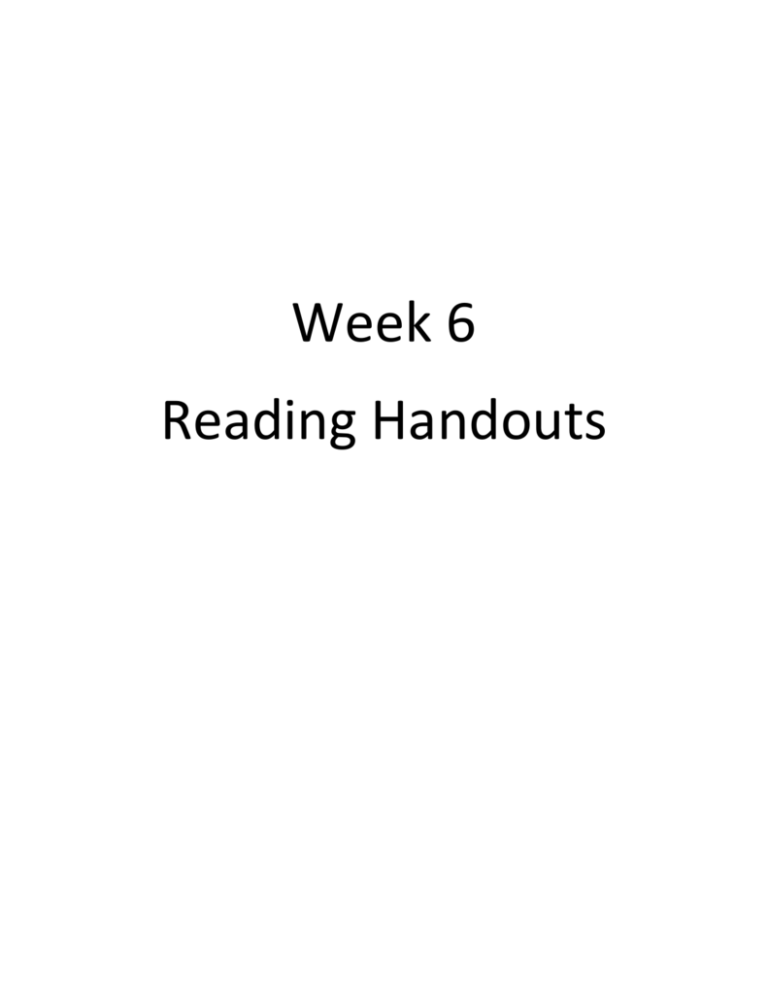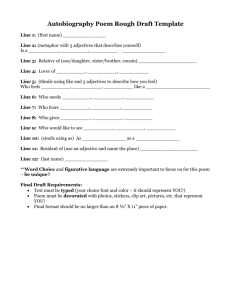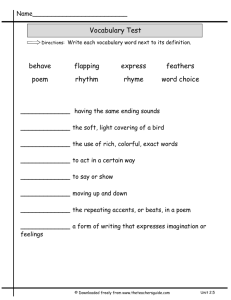Figurative Language
advertisement

Week 6 Reading Handouts Poetry – is a piece of writing in which words and their sounds are used to show images and express feelings and ideas. Noticings Author’s Purpose: to entertain or express Form: includes free verse, narrative, lyrical, and haiku Stanzas: the sections of a poem; a stanza may focus on one central idea or thought; lines in a stanza are arranged in a way that looks and sounds pleasing Book Examples Author’s Purpose: to entertain the reader with a funny poem that tells the story about a how a man lost his leg Form: narrative poem Stanzas: I saw the other day when I went shopping in the store A man I hadn't ever, ever seen in there before, A man whose leg was broken and who leaned upon a crutchI asked him very kindly if it hurt him very much. "Not at all!" said the broken-legg'd man. Rhyme: words that have the same ending sound may be used at the ends of lines to add interest to the poem and to make it fun to read I ran around behind him for I thought that I would see The broken leg all bandaged up and bent back at the knee; But I didn't see the leg at all, there wasn't any there, So I asked him very kindly if he had it hid somewhere. "Not at all!" said the broken-legg'd man. Rhyme: I ran around behind him for I thought that I would see The broken leg all bandaged up and bent back at the knee; But I didn't see the leg at all, there wasn't any there, So I asked him very kindly if he had it hid somewhere. "Not at all!" said the broken-legg'd man. Poetry – is a piece of writing in which words and their sounds are used to show images and express feelings and ideas. Noticings Rhythm: the beat of how the words are read; Add these to anchor chart on Friday may be fast or slow Sound Effects: Repetition occurs when poets repeat words, phrases, or lines in a poem to create a pattern, increase rhythm, and strengthen feelings, ideas and mood in a poem. Rhyme Scheme the pattern of rhyme that the poet uses Alliteration the repetition of the first consonant sound in words, as in the nursery rhyme “Peter Piper picked a peck of pickled peppers.” Book Examples Rhythm: The pickety fence The pickety fence Give it a lick it's The pickety fence Give it a lick it's A clickety fence When the night begins to fall And the sky begins to glow You look up and see the tall City of lights begin to grow – Repetition Someone tossed a pancake, A buttery, buttery, pancake. Someone tossed a pancake And flipped it up so high, That now I see the pancake, The buttery, buttery pancake, Now I see that pancake Stuck against the sky. actual sound of something are words of onomatopoeia. Thunder “booms,” rain “drips,” and the clock “ticks.”Appeals to the sense of sound. Imagery & Sensory Detail the use of Add on Monday to create images, or “paint pictures,” in your mind. Rhyme Scheme Alliteration Onomatopoeia Simile compares two things using the Imagery & Sensory Detail: Add on Tuesday Figurative Language tools that writers use words “like” or “as.” Metaphors compare two things without using the words “like” or “as.” Personification gives human traits and feelings to things that are not human – like animals or objects. The rhythm in this poem is slow – to match the night gently falling and the lights slowly coming on. Sound Effects: Onomatopoeia words that represent the words to create pictures, or images, in your mind. Appeals to the five senses: smell, sight, hearing, taste and touch. The rhythm in this poem is fast – to match the speed of the stick striking the fence. Figurative Language: Simile Metaphors Personification see specific anchor charts for examples Topic: State Fair Read the State Fair poem. Use this graphic organizer to collect sensory language that helps the reader create imagery. See Hear Smell Taste Feel Feelings State Fair The energy— thousands of people swarming about Moms pushing strollers couples holding hands teenagers bored with excitement kids running back and forth, around in circles laughing screaming, hot and sweaty. Everything at once— auto show carmel apples, nachos farm animals extreme rides squeal in delight “Announcing! The beginning of a show!” ice cream cone, funnel cake BMX bike show pig races spin the wheel toss the rings shoot the ball “I won! I won!” stuff the Snoopy under my arm chili and cheese fries Texas Skyway thirsty, dusty and dirty. Eyes wide open— Big Tex smiles and waves “Howdy Folks!” cotton candy, corn dogs each ride sings its own music Ferris Wheel stops at the top “Hurry! Hurry! Step right up!” sticky and sunburned. Long day ending— one more ride on the carousel, enough of the fried food the sweet cakes, the voices and laughter of a thousand people fading away, slowing down, dragging feet, dragging Snoopy, hot and sweaty, sticky, sunburned, dusty, dirty, “Where’s the car?” Topic: State Fair ***The highlighted Sensory Details are the ones you can use for modeling during your Minilesson. See Hear Smell Big Tex Ferris Wheel Thousands of people Auto Show Bike Show Farm Animals Crafts Rides – Texas Skyway, Extreme Rides, Carousel Games “Hurry, hurry! Step right up!” People laughing People screaming (on rides) Music playing An announcer shouting the beginning of a performance Everything is loud Fried food Sweet cakes Beer Animal smells in the barns Straw in the barns Taste Feel Feelings Cotton Candy Corn Dogs Ice Cream Cones Funnel Cakes Soda Carmel Apples Nachos Chili & Cheese Fries Hot Sweaty Sticky Sun burned Dusty Dirty Excited Lots of energy Want to do everything at once Eyes are wide Figurative Language Type of Figurative Language Simile Metaphor Personification Idiom Definition Example Comparison of 2 The emerald is as things using like or as green as grass. Comparison of 2 The night is a things but does not big, black cat. use like or as Giving human traits The moon smiled & feelings to things down at me. that are not human (animals/objects) Phrase that has a She’s pulling my figurative meaning leg. He laughed his head off. Figurative Language Type of Figurative Language Simile Definition Comparison of 2 things using like or as Metaphor Comparison of 2 things but does not use like or as Personification Giving human traits & feelings to things that are not human (animals/objects) Phrase that has a figurative meaning Idiom Example Big Bully Joe by Arden Davidson Big Bully Joe is a kid I know who’s as mean as a grizzly bear. He’s tall and he’s strong. We just don’t get along. There’s not one thing in common we share. When a baby’s diaper falls off, you know Joe took out the pins. Joe likes to torture little ones that’s how he gets his grins. When there’s gum in someone’s hair, you know it’s Joe who blew the bubble. When the teacher shouts “who did this?” you know Big Joe’s in big trouble. When a food does not agree with Joe he argues till he wins. He likes to fight. He also likes to kick dogs in their shins. He calls out horrid names to kids just doing their own thing. If he saw an injured bird, he’d likely break it’s other wing. Big Bully Joe is a kid I know who doesn’t have one single friend. But I heard Kelly Mayer put a tack on his chair. Guess he’ll pay for it all in the end! What it Looks Like on a Test… Read this sentence from paragraph ___ ___________________________________________ ___________________________________________ The imagery in these lines appeal most to the reader’s sense of – In paragraph ___, “a nightlight offering comfort from a bad dream” means that the light makes the boys feel – 4.8/Fig 19D What it Looks Like on a Test… The paragraph above the title of the poem is included to – 4.4/Fig 19D The reader can tell that the poem is written in free-verse form because it does not have – Which poetic structure is found in the poem? (Stanzas, Rhythm, Use of Repetition, Short Line Length) Which word rhyme in each stanza of the poem? 4.4A Carmen is a student at Pleasant Hill Elementary School. “Miss D.” is Carmen’s teacher. Miss D.’s mother, Grams, likes to visit the classroom and share her time with the students. In this poem, Miss D. asks the class to vote on how to spend the money left over at the end of the school year. CARMEN Secret Ballot by Andrea Cheng 5 10 15 20 25 School’s almost out. We have to spend the money somehow. We put suggestions on the board: Pizza party. Roller skating. How about thinking of other people? Miss D. says. Kayla raises her hand. A present for Grams, she says. What would Grams like? I put my head down and shut my eyes and think. A big picture of us in front of Pleasant Hill, I say. We vote on slips of paper called secret ballots. Pizza gets four, skating gets three, and the picture wins. From Where the Steps Were by Andrea Cheng. Copyright © 1994 by Andrea Cheng. Published by Wordsong, an imprint of Boyds Mills Press. Reprinted by permission. 1 The reader can tell that the poem is written in free-verse form because it does not have — A a serious subject B plot and conflict C a rhyming pattern D a common theme 2 Which poetic structure is found in the poem? A Stanzas B Rhythm C Use of repetition D Short line length 3 The paragraph above the title of the poem is included to — A help readers understand how the students feel about their teacher B persuade readers to write a poem about a special school event C encourage readers to think about their school experiences D provide background information about details that readers would not know






